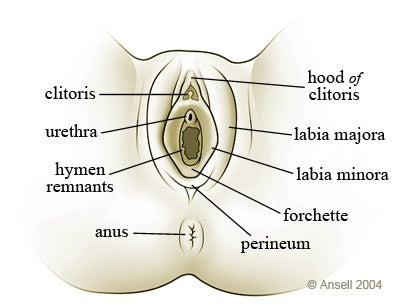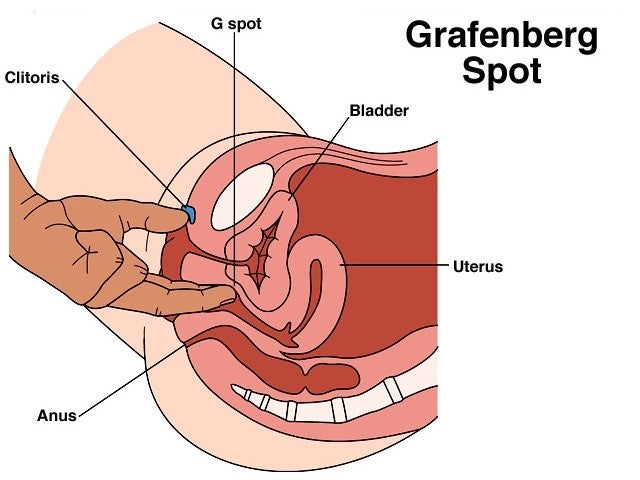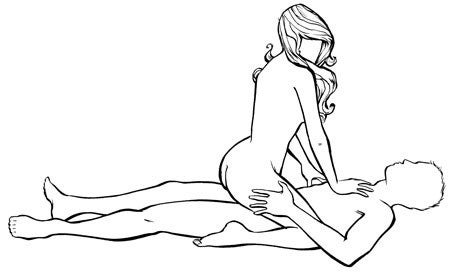
Note: Although this article refers to biological sex when describing human anatomy, we acknowledge that some individuals may not identify with their biological sex.
An orgasm is the intensely pleasurable physical and emotional sensations experienced at the climax of sexual arousal.1 It is the third and shortest phase of the Masters & Johnson sexual response cycle.1 The sexual response cycle has four main phases: excitement, plateau, orgasm, and resolution.1 Both males and females experience similar bodily reactions during an orgasm, but the length and intensity tend to vary between individuals. An orgasm involves the rapid, rhythmic contractions of the vaginal muscles in females and contractions of the muscles at the base of the penis in males. After an orgasm occurs, these muscles relax and are accompanied by a sense of intimacy, well-being, and fatigue.1 Orgasms arrive at the peak of sexual pleasure and feel like a release of built-up tension. This peak is followed by a feeling of calm euphoria where blood pressure, heart rate, and respiration return to normal levels.2 The intensity of an orgasm varies, because orgasms that are produced by short and fast buildups are less intense than orgasms produced by long and slow buildups.3 We encourage individuals to familiarize themselves with the physiological process of an orgasm and explore different sexual techniques to help them experience more intense orgasms.
The general characteristics of orgasms as experienced by both males and females include:
- dramatic increase in heart rate and blood pressure
- rapid, shallow breathing
- the appearance of flush (redness) in the face and/or the body
- involuntary muscle contractions, including spasms of the feet
- facial grimacing and involuntary vocalizations3
- sudden release of muscle tension
- intense, euphoric, and pleasant psychological feelings
However, male and female orgasms also differ in various ways.

Table of Contents
Male Characteristics
In males, we must first distinguish between an orgasm and ejaculation, because these are two separate bodily processes.3 An orgasm is the intensely pleasurable sensation at the peak of sexual arousal where males experience pleasurable pelvic muscle contractions and euphoria, among the general characteristics listed above, whereas an ejaculation is the pulsating expulsion of semen via the urethral opening of the penis.3 Both processes usually occur simultaneously and work together, but some males may experience an orgasm without ejaculating, or ejaculate without experiencing an orgasm.3 Male ejaculation consists of two stages: the emission stage and the expulsion stage.3
During the emission stage, semen builds up in the urethral bulb. This accumulation of semen is accompanied by a feeling of tension in the wall of the prostatic urethra, which is the section of the urethra that passes through the prostate gland, and signals inevitable ejaculation.4 The emission stage lasts approximately 2 to 3 seconds.1 Following emission is the expulsion stage, where the accumulated semen is released through the urethral opening. A ‘pumping’ feeling arises and the semen is then propelled out of the urethra by pulsating muscle contractions that occur approximately every 0.8 seconds in the pelvic muscles surrounding the urethra and urethral bulb.1,4 This entire process lasts between 10 to 15 seconds.1 Males generally experience intense sensations during the first few muscular contractions of an orgasm, which begin to subside during subsequent contractions.
After an orgasm, males typically enter a refractory period where they experience a release in tension and the temporary inability to orgasm, ejaculate, or achieve an erection.5 Most, if not all, males require a rest period before being able to orgasm again.3 Although there have been rare instances where a male has experienced an unusually short refractory period, it is uncommon for males to achieve multiple orgasms.5 This suggests that the refractory period is a nearly universal phenomenon in males.5 Check out our article on male masturbation to learn more.

Female Characteristics
Females also experience muscular contractions and intense sensations during an orgasm.1 Although the female orgasm and female ejaculation occur simultaneously in some cases, they are also different bodily processes. During an orgasm, females experience approximately eight to ten contractions, with one occurring every 0.8 seconds, in the pelvic muscles surrounding the vagina.1 Uterine and anal contractions may also occur at the same time.4 These intense muscle contractions are followed by weaker and slower contractions as they begin to subside.
Females generally do not have a refractory period and are more likely to be multiorgasmic, which means that they may experience multiple orgasms in a row.6 These subsequent orgasms may be even stronger than the first one.6 Female orgasms also tend to last longer than male orgasms, since the average duration of a female orgasm is between 10-20 seconds.1
Some, but not all, females may expel fluid out of their urethra during an orgasm, which is referred to as squirting, or female ejaculation. There appear to be two different kinds of fluids that are expelled out of the urethra during an ejaculation.1 The first kind of fluid collects in the bladder, in high-volume amounts, and resembles urine.1 In comparison, the second kind of fluid is a low-volume secretion from the paraurethral glands (Skene’s glands) that appears like a milky discharge.1 For some females, stimulation of the clitoris is the easiest way to heighten sexual arousal that leads to orgasm.6 Female ejaculation may also occur more easily if adequate pressure is placed on the G-spot.4 The location and existence of the G-spot have been contested by researchers, but it is said to be situated within the anterior (front) wall of the vagina.4

Orgasms and the Brain
The neurological (involving the brain and nervous system) and endocrinological (involving the glands that produce hormones) aspects of an orgasm are still an area of debate. More research is needed to produce conclusive results, but several studies offer insight into future pathways for research.
Dopamine
Studies examining the effects of dopamine suggest that this neurotransmitter plays a significant role in eliciting ejaculation.3,5 A Dutch group in 2003 used brain-imaging techniques to study males who were being stimulated by their female partners and found that the midline of the brain was highly active during an orgasm.1 This area contains many neurons that use dopamine as a neurotransmitter, which may suggest that the activation of dopamine during an orgasm is involved with the pleasure and reward system in the brain.1
Oxytocin
In addition, prolactin and oxytocin levels rise in both men and women following an orgasm, which may be correlated with the refractory period (particularly in males), because they inhibit further sexual behavior.5 Oxytocin, which is a hormone released by the pituitary gland in the brain following orgasm, may also contribute to the smooth contractions, like muscles in the uterus, and the pleasurable feelings during an orgasm.1 As shown by Emory University researchers in 2004, oxytocin may also have a role in pair bonding within sexual relationships because the injection of oxytocin into the brain of sexually promiscuous voles facilitated pair bonding.1 Therefore, oxytocin may affect one’s emotional bonds in sexual relationships. However, one study argues that it is unlikely that oxytocin causes the refractory period in the sexual response cycle because a double-blind placebo-controlled clinical study in 2008 demonstrated that oxytocin, as administered through the participants’ nasal cavity, had no effects on sexual behavior.3,5 Overall, more research is still needed.
Serotonin
Serotonin is believed to have an inhibitory effect on ejaculation and orgasm when activated in the brain stem in male rats.5 This belief originates from studies on SSRIs (selective serotonin reuptake inhibitors), which are antidepressant medications to treat depression or anxiety. The long-term use of SSRIs has side effects that may cause sexual dysfunction and impair ejaculation.3,5 Although serotonin may inhibit sexual behavior, this study is overly reductive because it does not account for studies that demonstrate exceptions or contradictions. For instance, in another study, the activation of various serotonin receptors appeared to stimulate erections and ejaculation when it was activated in the spine of male rats.5 Which is to say, serotonin may either activate or inhibit both ejaculation and orgasms depending on the location that is activated in the central nervous system.3 Overall, these studies give us insight into the way that orgasms are influenced by the brain, but more research is needed because several of these results are taken from studies that use animal trials, which cannot be accurately equated to results from human trials.5

Orgasmic Difficulties
Sometimes, a sexual response cycle may not include an orgasm or ejaculation, but individuals may still experience sexual satisfaction. However, other individuals who struggle to orgasm may experience discomfort or disappointment. Not all sexually active individuals have had an orgasm and even fewer individuals have experienced an orgasm the first time they had sex. In addition, females generally experience more difficulty in reaching orgasm than males.7 Reports of female orgasm difficulty range from 10% to 40% according to a 2018 study.8 For instance, females may experience orgasm difficulties due to the lack of learned skill in producing orgasms. Some females may not find the clitoris and other genital structures as easily as others because the clitoris can be easily overlooked in sexual education classes and during sexual encounters. In addition, some partners may not take an interest in helping to stimulate their female partner’s genitals and, in some cultures, they may even discourage female sexual exploration.1 These factors may delay a female’s sexual exploration and their ability to orgasm.1,9
In addition, studies have shown that an individual’s feelings surrounding sexual behavior influences their ability to orgasm. For example, Finnish researchers in 2016 found that individuals tended to experience less frequent orgasms if they did not have an emotionally healthy and sex-positive sexual relationship where their partner had good sexual technique and initiated sexual encounters at an equal rate.7 Anxiety, general distress, and distractions also increase the likelihood of orgasmic difficulty in both males and females.9 Research published in 2016 by The Journal of Sexual Medicine found that individuals who were distressed about their difficulty in reaching orgasm had a harder time reaching orgasm, due to their feelings of distress, and also reported less satisfaction in their sexual relationships.9 If you are interested in improving your sexual self-esteem, check out our articles on female orgasm difficulty, male orgasm difficulty, and body image.

Treatment
Males who have difficulty in achieving or maintaining erections, or reaching an orgasm, may benefit from looking at 26 FDA approved sexual enhancement treatments.Women, however, do not have many available FDA approved sexual enhancement treatments for them. One FDA approved device to treat female sexual dysfunction is the EROS CDT (clitoral therapy device).11 This device is prescribed to women who suffer from female sexual arousal disorder symptoms, such as reduced sensation, reduced lubrication, and the inability to orgasm.11 This device consists of a vacuum pump that is placed over the clitoris that increases blood flow to the region, thus increasing sexual arousal.11 Another FDA approved treatment is Addyi (Flibanserin), which is an orally ingested drug used to treat hypoactive (low) sexual desire disorder (HSDD).12 Addyi targets a chemical imbalance in a female’s brain by enhancing the release of chemicals (like serotonin) to stimulate sexual interest.13 We encourage individuals talk to their doctor or healthcare professional before taking any medications or starting any non-FDA approved treatments.
Although females may not have many easily available treatments for orgasm difficulties, there are plenty of other ways to treat an orgasm deficit. Studies have shown that males experience orgasms more frequently than females, with one study demonstrating that approximately 90% of males usually experience an orgasm during sex, whereas females may only experience orgasms during sex 50% of the time.7 To mitigate this, some females may need the extra help of manual stimulation, oral stimulation, or sex toys to orgasm. Individuals may also try to stimulate their non-genital erogenous zones, which are pleasurable areas of the body that contain many sensitive nerve endings capable of producing sexual arousal.14 Most females reliably report to have more orgasms from masturbation, or with simultaneous clitoral and G-spot stimulation during sex, when compared to sexual intercourse alone. For instance, the Journal of Sexual Medicine studied orgasmic latency (the time delay before an orgasm) in 2,304 female participants and found that the orgasmic latency during partnered sex is significantly longer than during masturbation.10 This may show that sexual intercourse may not be as sexually stimulating as masturbation, where the female may incorporate other highly sensitive zones, like the clitoris, into their masturbation session.

Stimulating Areas
Pleasurable Techniques for Females
It is worthwhile for individuals to learn how to effectively provide themselves and others with plenty of sexual stimulation. Although intercourse alone usually brings males to orgasm, vaginal stimulation and penetration alone does not always work for females.7 Different areas on a female’s external genitalia vary in their levels of sexual sensitivity. Due to this variety, there are multiple ways in which a female can reach orgasm. Females may orgasm more easily through the stimulation of various structures like the labia minora, the clitoris (and its internal structures), the vagina, the g-spot, and sometimes the cervix.6
The most sexually stimulating area of a female’s body is the clitoris. The clitoris is located at the top of the vulva and contains many nerve endings, which makes it a highly sensitive area that is the most reliable way to produce an orgasm.1 However, the location of the clitoris may prevent it from being stimulated through vaginal sex alone.6 The clitoris is often best stimulated manually, orally, or with sex toys.
Individuals can experiment with different kinds of stimulation to discover what feels best. Different rhythmic patterns of clitoral stimulation can also be explored, including: circular, up and down (vertical), and back and forth motions.1 Individuals may also vary the pressure of stimulation by transitioning from gentler to stronger forms of stimulation, especially as they near orgasm.1 Females may also stimulate multiple areas of their genitalia at once by inserting a finger or two into the vagina while simultaneously stimulating the clitoris with another finger. Partners may also stimulate the individual’s clitoris with their tongue. Individuals are encouraged to masturbate and explore their body. They may also let their partner watch, so they can learn what the individual likes.

The Grafenberg spot, also known as the G-spot, is also another sensitive area of the vagina. It is located about 2 to 3 inches up on the anterior wall of the vagina.1 Although the existence of the G-spot has not been proven, many females report feeling enhanced pleasure and orgasms from the stimulation of this area.4 To locate the G-spot, individuals should insert a finger or two into the vagina, curl the fingers upward, and move their finger in a “come here” motion.1 Females have described that G-spot orgasms resemble the need to urinate.

Pleasurable Techniques for Males
For males, the most sensitive zones include the frenulum and the glans. The frenulum is a small band of tissue on the underside of the glans. The glans, or head, is the cone-shaped structure at the tip of the penis that is connected to the shaft.
The perineum also has many nerve endings and is sexually stimulating for both males and females when pressure is applied. The perineum is the area between a female’s introitus and anus, and between a male’s testicles and anus. When manually or orally stimulating a partner, one may gently press on their perineum to increase pleasure as well. This is also a great way to give male partners an even better orgasm. When giving oral sex, or riding a male in reverse cowgirl position, one can lick one’s fingers to provide some lubrication, and gently press on the male’s perineum when they are about to climax.
The testicles are also sexually stimulating for males. Lightly cupping their testicles during oral or penetrative sex, as well as lightly sucking and licking them, can increase pleasurable sensations. Because testicles are very sensitive, individuals should not grab, bite, or suck on them too hard. Individuals may also stimulate the different erogenous zones for males simultaneously. When a male is about to climax during penetrative sex, one may lightly cup their testicles and press on their perineum, which effectively stimulates all three points at once (their penis, testicles, and perineum).

Anal Stimulation
Anal stimulation can also be sexually arousing for both males and females and it is a wonderful way to spice up one’s sex life. Some males and females who feel comfortable engaging in anal stimulation with their partner report being able to achieve stronger orgasms. The primary source of pleasure for females and males within the rectum is the anus, or the sphincter itself, which contains many highly sensitive nerve endings.1
Males may also experience prostate stimulation via the anus. The prostate, sometimes referred to as the male G-spot, is a walnut-sized gland located below the bladder. This gland secretes a fluid that helps sperm to survive outside of the body and comprises 30% of the male’s ejaculate.1 The best way to stimulate the prostate is to slowly insert a well lubricated finger into the anus, facing the bladder, and move one’s finger in a “come hither” motion. Some sex toys are designed to apply stimulation to the prostate. In addition, orgasms that are induced by massaging the prostate differ from orgasms that are produced by penile stimulation. A prostate-induced orgasm has been shown to produce approximately 12 contractions, whereas a penile induced orgasm produces between four to eight contractions.3 These prostate induced orgasms may be significantly stronger for males as the sensations ripple over larger areas of the body, but they require practice and may not be pleasurable for all males.3
Whenever engaging in anal stimulation, it is worthwhile to remember to be clean, go slowly, use protection, use lubrication, listen to one’s body, communicate with one’s partner, trim one’s nails, and use appropriately sized sex toys with a flared base. Individuals should use plenty of lubrication because the walls of the rectum may tear more easily as the anus does not provide natural lubrication.1 One’s feelings toward engaging in anal sex, just like with any sexual activity, can affect how enjoyable it is.

Sex Positions
Aside from manual and oral stimulation, sexual intercourse is another method for experiencing exhilarating orgasms. Both female and male same-sex couples are also encouraged to explore these thrilling sex positions. Although manual and oral stimulation are the most effective techniques for stimulating the clitoris, it can also be stimulated simultaneously while having intercourse. Explore different sex positions with your partner to provide more clitoral stimulation. The female on top position gives the female or male receptive partner the ability to control the speed and range of their movements when they are being penetrated, while their insertive partner can simultaneously access their erogenous zones (like a female’s breasts or a male’s nipples).1 By sitting on their partner, a female may either rub their clitoris against their partner’s abdomen or manually stimulate it, which provides added stimulation and pleasure. For male same-sex couples, this position may also take advantage of the curvature of the penis, when it is angled toward the bladder, to stimulate the male receptive partner’s prostate. Doggy style, or penetration from behind, is a commonly used sex position that may stimulate the clitoris and G-spot. Due to the curvature of the penis, and the angle at which it enters the vagina, it is more likely to hit the G-spot.

Standing doggy style may also direct the male’s penis at an even better angle to stimulate the G-spot. While in this position, the insertive partner may use one of their hands to manually stimulate their partner’s clitoris, or they may manually stimulate their own clitoris. When having sex with a female, female insertive partners may also take advantage of this technique by using a strap-on dildo (and penetrating their partner). Individuals should always make sure to clean dildos well, use plenty of lubrication, and use the appropriate sized sex toy for their experience and comfort level. If one is exploring the missionary position, the insertive partner may try placing a few pillows beneath the receptive partner’s butt to align their pelvis into a better position for their partner’s penis to press either the female’s G-spot or the male’s prostate. Similarly, to stimulate a male partner’s prostate, the insertive partner may also approach their male receptive partner (who is lying down on their back) from the front. These are just a small number of sex positions that can better stimulate the clitoris, G-spot, and prostate.1 Feel free to explore a variety of sex positions with your partner to find out which ones provide the most pleasurable orgasms.

Negative Emotions
One of the biggest obstacles preventing males and females from reaching orgasm, is the presence of negative emotions, including fear, anxiety, or guilt. With the long history of taboos against women enjoying sexual pleasure, it is not uncommon for women to feel guilty for engaging in sexual acts. It is important to let go of guilt and realize that it is normal and healthy to enjoy masturbation and sex. Both males and females may feel scared or anxious when having sexual intercourse for a variety of reasons, including first time sex worries and performance anxiety. These worries, however, distract individuals from sexual pleasure and make it more difficult for them to reach orgasm. The best way for individuals to achieve an orgasm is to relax and not worry about the outcome. When exploring oneself, individuals should turn off all distractions and try to clear their mind of any anxious feelings by focusing on the present sexual pleasures. Looking at one’s partner as they stimulate you, or closing your eyes and focusing on the bodily sensations, can keep one’s mind grounded during sex. Ask your partner for feedback on what you are doing and reassure them if you like what they are doing too. Pay attention to the physical reactions and vocalizations from your partner to improve your techniques. These physical signs can give you some insight into what they like. Essentially, trust and honest communication with your partner can make orgasms more enjoyable.

Concluding Remarks
Individuals who have trouble reaching an orgasm are encouraged to try different stimulation techniques and promote a positive environment during sex. Even if one does not have problems achieving orgasm, one may explore new techniques and sex positions to make one’s orgasms even more pleasurable. Regardless of one’s expectations, it is worthwhile to remember that sex is more than just reaching orgasm. Not having an orgasm during every sexual encounter is not a sign of a personal inadequacy. Sex can still be a highly pleasurable and satisfying experience even without orgasms. One should enjoy all of the physical sensations that come with sex and celebrate the physical and emotional intimacy that it may bring to one’s sex life. It certainly transforms sex into an exhilarating experience!
References
- LeVay, Simon, et al. Discovering Human Sexuality. Third ed. Sunderland, MA: Sinauer Associates, 2015. Print.
- Levin, Roy J. “An Orgasm Is…Who Defines What an Orgasm Is?” Sexual and Relationship Therapy, Volume 19, Issue 1, 2004.
- Alwaal, Amjad, et al. “Normal Male Sexual Function: Emphasis on Orgasm and Ejaculation.” Fertility and Sterility, Volume 104, Issue 5, 2015.
- Levin, Roy J., Alan Riley. “The Physiology of Human Sexual Function.” Psychology, Volume 6, Issue 3, 2007.
- Seizert, Curtis A. “The Neurobiology of the Male Sexual Refractory Period.” Neuroscience & Biobehavioral Reviews, Volume 92, 2018.
- Levin, Roy J. “The Pharmacology of the Human Female Orgasm: Its Biological and Physiological Backgrounds.” Pharmacology Biochemistry and Behavior, Volume 121, 2014.
- Kontula, Osmo, Anneli Miettinen. “Determinants of Female Sexual Orgasms.” Socioaffective Neuroscience & Psychology, Volume 6, 2016.
- Rowland, David L., et al. “Women’s Attributions Regarding Why They Have Difficulty Reaching Orgasm.” Journal of Sex & Marital Therapy, Volume 44, Issue 5, 2018.
- Rowland, David L., Tiffany N. Kolba. “Understanding Orgasmic Difficulty in Females.” The Journal of Sexual Medicine, Volume 13, Issue 8, 2016.
- Rowland, David L., et al. “Orgasmic Latency and Related Parameters in Women During Partnered and Masturbatory Sex.” The Journal of Sexual Medicine, Volume 15, Issue 10, 2018.
- Josefson, Debbie. “FDA Approves Device for Female Sexual Dysfunction.” British Medical Journal, 2000.
- “FDA Orders Important Safety Labeling Changes for Addyi.” FDA. Apr. 2019. Web. 14 May 2019.
- Addyi (Flibanserin) | Official site, Addyi. Web. 14 May 2019.
- Nummenmaa, Lauri, et al. “Topography of Human Erogenous Zones.” Archives of Sexual Behavior, Volume 45, Issue 5, 2016.
Last Updated: 28 May 2019.
